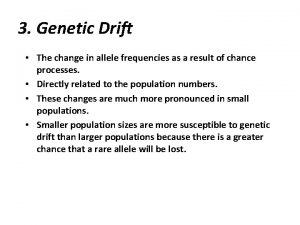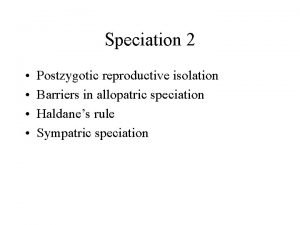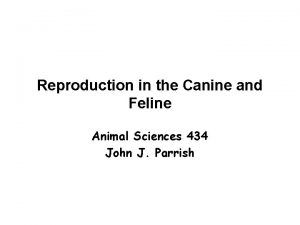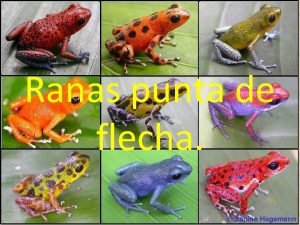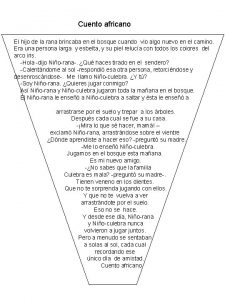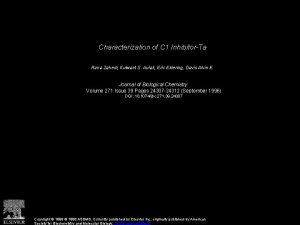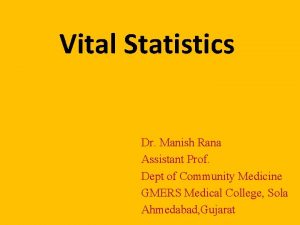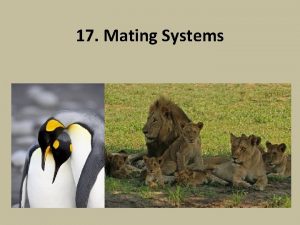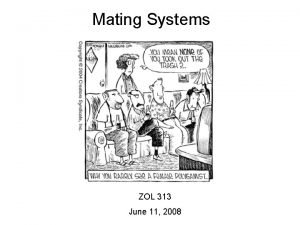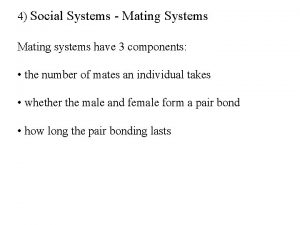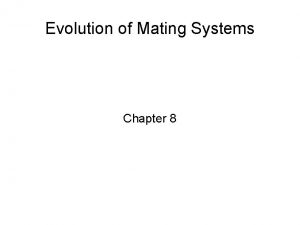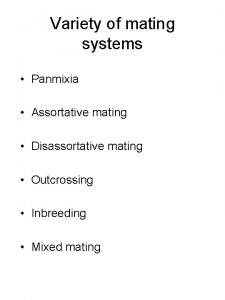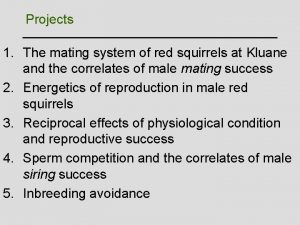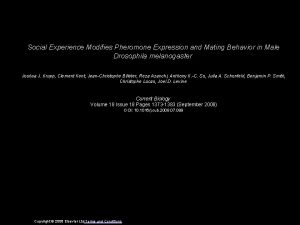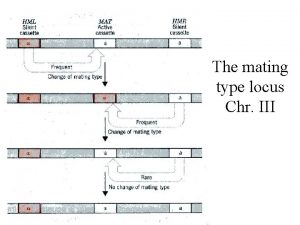The mating system of Rana adenopleura 2007124 Introduction






























- Slides: 30

The mating system of Rana adenopleura 2007/12/4

Introduction Methods Animal model and study site Field procedure Preliminary result Behaviour Male mating success Mating system

Introduction Methods Animal model and study site Field procedure Preliminary result Behaviour Male mating success Mating system

Mating systems are according to polygamy level mating system mating type OSR polygyny Female defence Unpredictable Resource defence ♂biased Lek ? Scramble Competition Unity Male defence ♀biased Resource defence ♀biased monogamy Mate-guarding/assistance Unity polygamy Resource use Unity polyandry (modified from Sullivan et al 1995) (Emlen and Oring 1977; Wells 1977 a; Davies 1991)

Life histories and biological factors that influence mating system Parental care Breeding period Inter sex and intra sex selection Operational sex ratio Timing of reproduction Territorial behavior was well known in the taxa of fishes, reptiles, avian, and mammals

However, Resource defense polygyny has been reported (Sullivan et al 1995) rarely in anuran The details of breeding biology are not known for most anuran species, especially in tropical regions (Tsuji 2004)

Purpose 1) Identify territoriality of R. adenopleura males 2) The temporal and spatial pattern of males 3) Identify the factors of male mating success 4) Confirm the mating system of R. adenopleura

Experiment 1 The mating system of Rana adenopleura Introduction Methods Animal model and study site Field procedure Preliminary result Behaviour Male mating success Mating system

The species Oliver frog (Rana adenopleura) Family Ranidae, genus Rana) (Chuang 2006)

The species- sexual dimorphism Vocal sac (Duellman and Trueb 1986) ♂ Shoulder gland ♀ (Thomas et al 1993)

The species- sexual dimorphism ♀>♂ *** t=6. 1 df=133 p<0. 0001 *** t=5. 61 df=133 p<0. 0001

Study site

Field procedure 27 nights (12 Aug – 7 Sep) Censuses during whole night Body size measurement (SVL & weight) Individual mark (waist bands , tags, toe clipping) tag Numbered waist band

Experiment 1 The mating system of Rana adenopleura Introduction Methods Animal model and study site Field procedure Preliminary result Behaviour Male mating success Mating system

Behavior of males Males defended their territory by vocalization and aggressive behavior Most territories were near shore

Behavior of males

Behavior of males

Behavior of males-Playback experiment

Behavior of males

Behavior of females Females adopt a low posture to close calling males Females approach males very slowly and easily disturbed

Oviposition behavior Female spontaneously back her body under male’s Males do not clasp female until physical contact After laid eggs, males restart calling immediately

How to establish a calling site Males without territory often adopt trial and error fight

Male mating success ♀ ♂ ♀ ♀

Male mating success 52 egg mass in 27 nights 24% (9/38) marled males mated at least once 1. 37 ± 4. 69 for all males 5. 78 ± 8. 56 for mated males

Male mating success R=0. 63 P=0. 067 Dependent variable Independent variable r Male mating success SVL -0. 53 0. 122 Body mass 0. 09 0. 99 Shoulder gland 0. 15 0. 34 No. nights present 0. 63 0. 067 � p<0. 1 P �

Mating system 1. Prolonged breeder lasting at least 6 month (Chuang 2006) Sex ratio (adult females/adult males) Overall – 2. 82 (107/38) Highly biased toward females !! (Wells 1977 a)

Mating system Adult sex ratio Males and females qualified to mate Males competition results in a female-biased operational sex ratio (Ahnesjo et al 2001 )

Mating system 2. Resource-defense polygyny Males defend territories include oviposition sites Males may be able to predict suitable oviposition sites Species R. catesbeiana R. clamitans R. kuhlii Females favor warmer water dense vegetation weak current creek source Howard 1978 Wells 1977 b Tsuji 1998 (Emlen and Oring 1977, Sullivan et al 1995)

Mating system 3. Polygamy Frequent oviposition by females in a breeding season Female No. 15 26 Oviposition date 8/15 9/3 8/16 clutch size 509 357 217 9/2 238 (Sullivan et al 1995, Tsuji 2004)

Conclusion Male R. adenopleura have strong aggressive territoriality, they defense a territory for calling, mating, and oviposition The territorial males tend to maintain a site for a long time The male body size and present days were not correlated to mating success Mating system prolonged breeder, resource-defense polygyny, polygamy
 Non random mating
Non random mating Assortative mating
Assortative mating Assortative mating
Assortative mating Dog semen collection
Dog semen collection Rana yağcı
Rana yağcı Escarabajo choresine
Escarabajo choresine Rana renesansa u italiji
Rana renesansa u italiji Renesansa u italiji
Renesansa u italiji Nursing organizational chart in hospital
Nursing organizational chart in hospital Consonante y asonante
Consonante y asonante Cuando la rana y la culebra jugaron juntas
Cuando la rana y la culebra jugaron juntas Dr anjum sameena
Dr anjum sameena Aparato digestivo en reptiles
Aparato digestivo en reptiles Dr h s rana
Dr h s rana Cuento el hijo de rana
Cuento el hijo de rana Como hacer un pito
Como hacer un pito Clase de sonido
Clase de sonido Rana zahedi
Rana zahedi Renesansa u italiji
Renesansa u italiji Delfinata
Delfinata Raná grécka filozofia
Raná grécka filozofia Boca de rana
Boca de rana Drowning froth
Drowning froth Dr. anjum rana
Dr. anjum rana Asmfr
Asmfr Rana ghoneim
Rana ghoneim Rana plaza
Rana plaza Rimas de foco
Rimas de foco Resuelve las siguientes situaciones
Resuelve las siguientes situaciones Rana plaza
Rana plaza Hoppbakke mo i rana
Hoppbakke mo i rana
